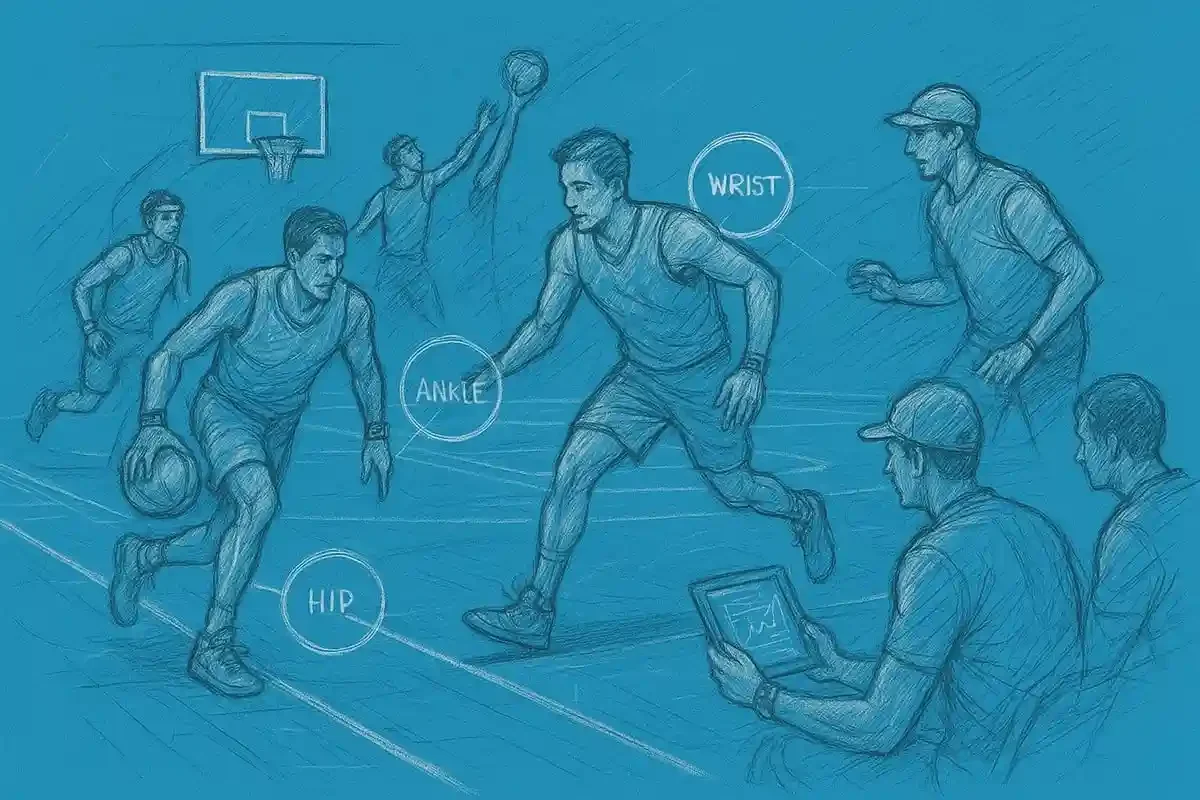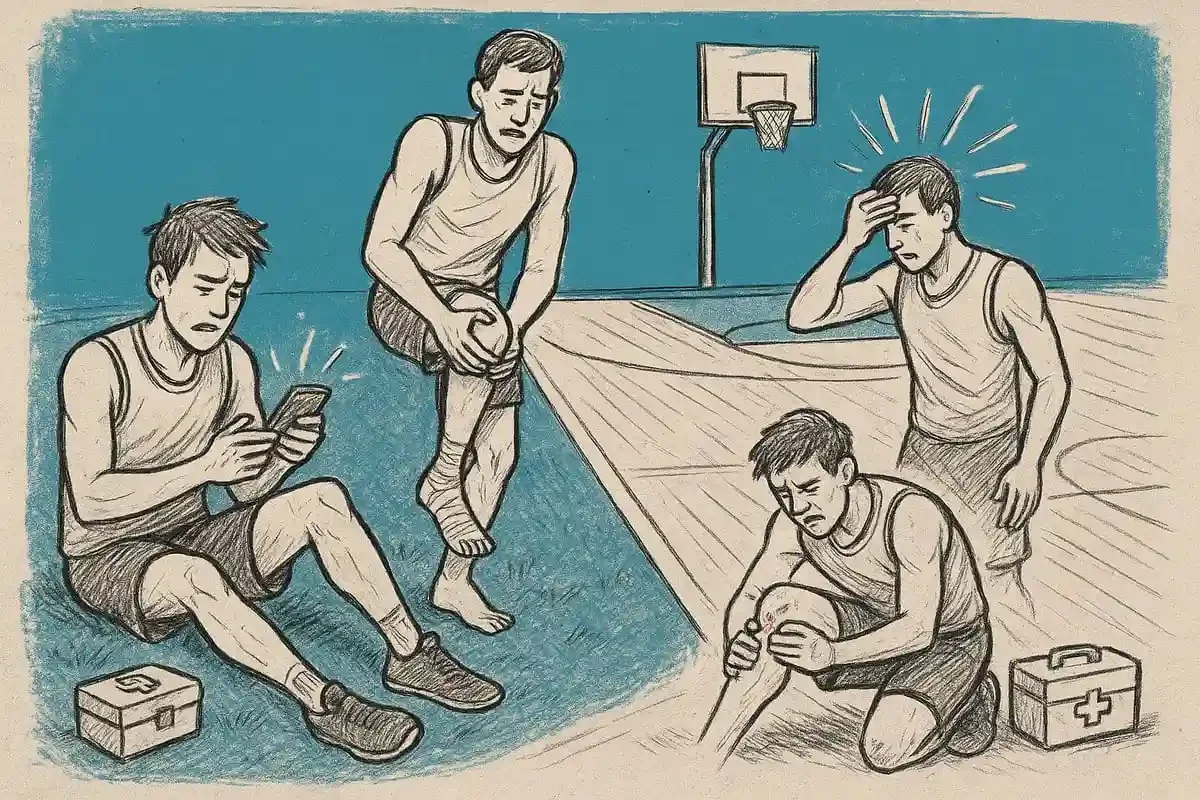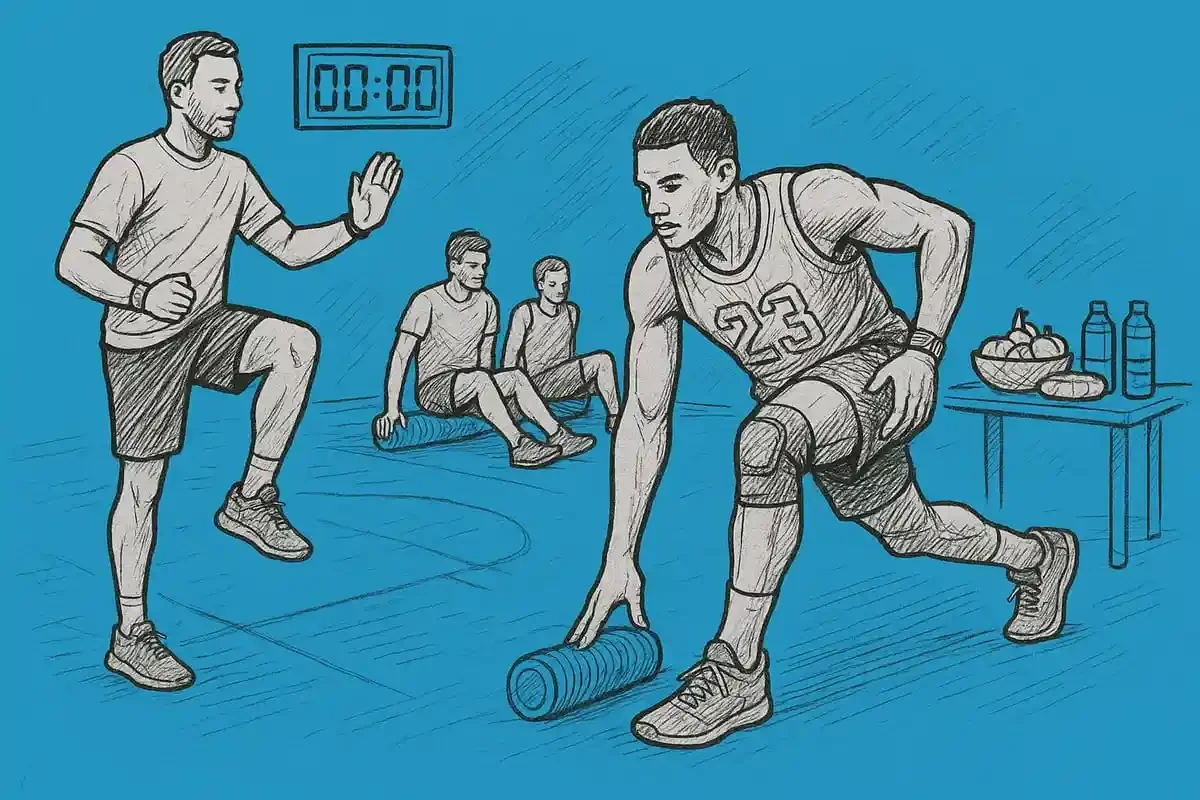7 Basketball Injuries Players Face in 2025
Did you know that basketball injuries in 2025 are more unpredictable than ever? Even seasoned players are facing new threats that can take them off the court without warning.
As the game speeds up and training methods evolve, athletes must adapt to a wave of unexpected challenges. This article uncovers seven common basketball injuries and shares expert-backed prevention strategies.
Curious about protecting your game and health? Stay tuned for insights that could keep you one step ahead of the competition.
The Changing Landscape of Basketball Injuries in 2025
Basketball injuries are evolving in 2025, reflecting a sport that is faster, smarter, and more technologically advanced than ever. Players, coaches, and parents are noticing patterns that simply did not exist a decade ago. Understanding these shifts is essential for anyone invested in player health and long-term performance.
Evolution of the Game and Injury Patterns
Over the past decade, basketball has transformed dramatically. The game's pace is quicker, with more possessions per minute and explosive transitions. This high-speed style means athletes face more physical demands, which has led to a shift in the types of basketball injuries seen on the court.
Advanced training regimens and the rise of year-round play are pushing athletes harder, often from a younger age. Early specialization, where youth focus on basketball only, is linked to increased overuse and non-traditional injuries. Athletic trainers now report a broader range of injuries, including stress fractures and chronic joint issues in younger players. Comparing 2015 to 2025, ankle sprains remain one of the most likely injuries, with a surge in hand, hip, and overuse injuries.
The Role of Technology and Data
Technology is playing a double-edged role in the landscape of basketball injuries. Wearable devices and AI-powered analytics are becoming more commonplace. These tools track player movement, workload, and can help inform injury risk. Load monitoring has revealed that inconsistent rest cycles paired with bouts of high load - well beyond what the athlete is accustomed to, contribute to fatigue-related noncontact injuries.
External Factors and Prevention Awareness
External factors are further shaping the injury landscape. Climate changes, such as hotter gym environments, can increase dehydration and fatigue, raising the risk of muscle strains.
Coaches, parents, and players must adapt to these changes by prioritizing prevention and early recognition. Awareness campaigns and injury surveillance programs are becoming standard, helping teams identify and address emerging basketball injuries before they become chronic. Staying proactive and informed is crucial as the sport continues to evolve and present new challenges.
7 Common Basketball Injuries Players Face in 2025
The world of basketball injuries is evolving quickly. As we head into 2025, athletes and coaches are facing a wave of unexpected challenges.
Below, we explore seven basketball injuries that are reshaping the game. Each one presents unique symptoms, risks, and prevention strategies every player should know.
1. [Inversion Ankle Sprains]
Ankle sprains are the most common injury seen in basketball. The high impact, fast paced and multi-directional nature of the sport can result in players rolling their ankle inadvertently by landing on another players foot, or buckling with abrupt transitions.
Symptoms include:
Pain at site of injury
Swelling in ankle
Difficulty weightbearing
Not only is this injury very common as a first-time injury, the likelihood of re-injury with 6-12 months following the first injury has been reports to be as high as 8x more likely.
Prevention strategies for basketball injuries like this include:
Ankle proprioceptive training
Prophylactic use of ankle braces
Ankle strengthening exercises
2. [Stress Fractures]
Fatigue or stress fractures are an emerging trend among basketball injuries, especially in younger athletes. These fractures often affect the tibia, metatarsals, and lumbar vertebrae.
Why are they increasing? Aggressive load management protocols, which sometimes create abrupt changes in playing time, can stress bones not fully adapted to sudden activity spikes.
Common warning signs:
Persistent localized pain during or after activity
Swelling or tenderness at the injury site
Decreased performance or limping
Case example: A promising high school guard dramatically increased playing time after a period of rest, only to develop a tibial stress fracture.
Prevention tips for basketball injuries in this category:
Gradually ramp up playing time after rest
Monitor bone health through regular screenings
Prioritize nutrition rich in calcium and vitamin D
There is a paradox: while load management aims to protect, poor implementation can increase injury risk. Early detection and proper recovery protocols are essential.
3. [Patellar Tendinitis]
The patellar tendon sees a tremendous amount of load given the amount of stop-start movements, jumps, and landings that are performed in the sport. If load exceeds the capacity of the tendon, patellar tendinitis may ensue.
Symptoms to watch for:
Pain over the patellar tendon
Swelling around patellar tendon
Pain may improve a bit as the player warms up, just to feel worse late game or once the body has cooled down.
Prevention strategies for basketball injuries like patellar tendinitis:
Patellar tendon loading protocols like Spanish squats, wall sits
Proactively monitor player load to minimize likelihood of developing patellar tendinitis
Equipment recommendations:
Patellar straps may be used strategically to offset load going through the tendon. While this may help with symptom modification in the short-term, it is not a long term solution.
4. [Achilles Tendinitis]
Much like patellar tendinitis, Achilles tendinitis can develop due to the load on the tendon exceeding it's capacity. Explosive drives to the net and jumping/landing are the primary stresses to the tendon.
Symptoms include:
Pain and stiffness in the Achilles tendon
Swelling at the site of pain
Calf tightness is common with this condition
Prevention techniques for these basketball injuries:
Prophylactic calf stretching
Heavy slow loading and eccentric/negative exercises
Proper fitting footwear
5. [Anterior Hip Impingement]
Anterior hip impingement is quite common in basketball players. Modern basketball emphasizes explosive cuts and pivoting with a abrupt flexed/internally rotation position of the hip, increasing stress on the hip joint.
Symptoms to recognize:
Groin pain during movement or after games
Reduced hip mobility, especially during deep hip flexion of flexion when coupled with adduction or internal rotation
A catching or locking sensation in the joint
Prevention and management for basketball injuries like this:
Prioritize dynamic warm-ups with hip mobility exercises
Address pain early with physical therapy
Modify drills if hip discomfort develops
If left untreated, this injury can lead to chronic pain and even require surgery. Early intervention improves both recovery time and long-term outcomes.
6. [Low Back Pain]
Low back pain is one of the most common injuries in the general population, and basketball players are no exception to the rule. Basketball is fast paced and like other weightbearing part of the body, the low back seeing lots of stress through repeated jumps, landings, and stop-start movements.
Mechanism of injury:
Can develop gradually or with a specific movement such as a fall or twisting motion of the spine
Prevention for these basketball injuries involves:
Hip mobility exercises. More accessible hip ROM often helps with taking stress off the back
Core stability programming
7. [Plantar Fasciitis]
Plantar fasciitis is becoming a top concern among basketball injuries.
Symptoms to look for:
Persistent heel pain, especially in the morning or after games
Tenderness along the bottom of the foot
Swelling or stiffness after activity
Even star players have missed games due to chronic foot pain, despite wearing top of the line footwear.
Prevention tips for basketball injuries in this category:
Careful shoe selection based on foot type and playing style
Incorporate foot strengthening and foot and calf stretching routines
Address early symptoms promptly
Not all high-cushion shoes are created equal. Understanding the pros and cons of different models is vital. For players dealing with persistent pain, exploring advanced plantar fasciitis treatment options can make a significant difference.
Rehabilitation may involve rest, physical therapy, and sometimes medical intervention. Ignoring symptoms can lead to long-term issues and decreased career longevity.
Prevention Strategies for Modern Basketball Injuries
Modern basketball is evolving rapidly, and so are the risks athletes face. Preventing basketball injuries now requires more than just basic stretching or taping. Players, coaches, and parents must adopt updated strategies that address the unique demands of today's high-speed, tech-driven game.
Comprehensive Warm-Up and Cool-Down Routines
A tailored warm-up is essential for reducing basketball injuries. Focus on dynamic stretches, movement-specific drills, and sport-specific activation. After games or intense practices, cool-down routines help promote recovery and reduce muscle soreness.
Include light cardio and movement prep
Follow with active stretching for flexibility
End with foam rolling or massage for muscle health
Committing to these routines helps athletes avoid common strains and sprains.
Mobility, Stability, and Proprioception Drills
Integrating mobility and stability drills into training is vital for preventing basketball injuries. These exercises improve joint health and body awareness, making athletes more resilient to unexpected movements or awkward landings.
Add balance work (like single-leg stands)
Use resistance bands for joint stability
Practice agility ladder drills for proprioception
Improved movement quality directly lowers injury risk.
Sports Nutrition and Hydration
Fueling the body properly is a cornerstone of injury prevention. Dehydration or poor nutrition can lead to fatigue and make players more susceptible to overuse basketball injuries.
Drink water before, during, and after play
Eat balanced meals with lean proteins, healthy fats, and complex carbs
Time snacks for optimal energy and recovery
Smart nutrition choices support muscle repair and reduce inflammation.
Responsible Technology Use
With the rise of wearables and AR tools, technology now plays a bigger role in tracking player workload and performance. However, overreliance or improper use can contribute to basketball injuries.
Set limits on device use during practice and breaks
Choose ergonomic, athlete-friendly devices
Use technology to monitor, not replace, expert guidance
Balance is key to harnessing tech benefits while staying safe.
Education and Early Warning Sign Recognition
Teaching athletes and coaches to recognize the early signs of basketball injuries is crucial. Minor symptoms, if ignored, can turn into chronic problems.
Hold regular injury prevention workshops
Encourage open communication about pain or discomfort
Partner with athletic trainers for ongoing support
A proactive approach leads to quicker interventions and fewer missed games.
Team-Wide Prevention Programs
Implementing team-wide prevention programs boosts accountability and results. For in-depth strategies, check out these prehab and injury prevention tips designed for athletes at every level.
Regular screenings, group warm-ups, and injury surveillance help teams adapt as the game changes. Staying up to date with best practices ensures that basketball injuries are minimized, keeping players on the court and performing at their best.
Recognizing and Managing Early Signs of Injury
Spotting the early warning signs of basketball injuries is crucial for minimizing downtime and avoiding long-term problems. Athletes, coaches, and parents should be alert to subtle symptoms that often signal bigger issues ahead.
When should you try self-care and when is it time to call in a pro? For most minor basketball injuries, rest, ice, and monitoring can help. But if pain worsens, swelling persists, or movement is limited, it’s time to consult a healthcare professional. Ignoring these signs can turn a simple issue into a chronic setback.
Athletic trainers and sports medicine experts play a vital role in early intervention. Their expertise helps athletes recognize patterns before problems escalate. For example, some pros and youth players have prevented serious setbacks by acting quickly on nagging symptoms. Getting advice from a sports injury chiropractor can also be a game-changer for managing basketball injuries at their earliest stages.
Stay proactive by listening to your body. Addressing minor symptoms now keeps you on the court and out of the treatment room.
The Future of Basketball Injury Prevention and Player Health
As basketball continues to evolve, so do the tools and strategies for preventing injuries. The next wave of innovation includes advanced injury prediction algorithms, smart wearable gear, and highly personalized rehabilitation programs.
Multidisciplinary care is becoming the norm, with experts in chiropractic, physiotherapy, and sports medicine working together to keep athletes on the court. Continued research, such as the Epidemiology of Basketball Injuries: Systematic Review, highlights how crucial it is to stay informed about the latest trends in basketball injuries.
For players and coaches, ongoing education and adaptation are essential. Embracing new technology and prevention strategies helps ensure long-term health and peak performance. Staying proactive is the smartest play in the ever-changing game of basketball.
After seeing just how quickly basketball injuries are evolving in 2025, it’s clear that staying on top of your game means paying attention to even the smallest signs of strain or discomfort. Whether you’re dealing with nagging aches or want to prevent issues before they start, expert care can make all the difference in your recovery and performance. If you’re ready to feel your best—on or off the court—you can Book with one of our chiropractors today and get personalized support from a team that truly understands sports injuries. Your body will thank you!




